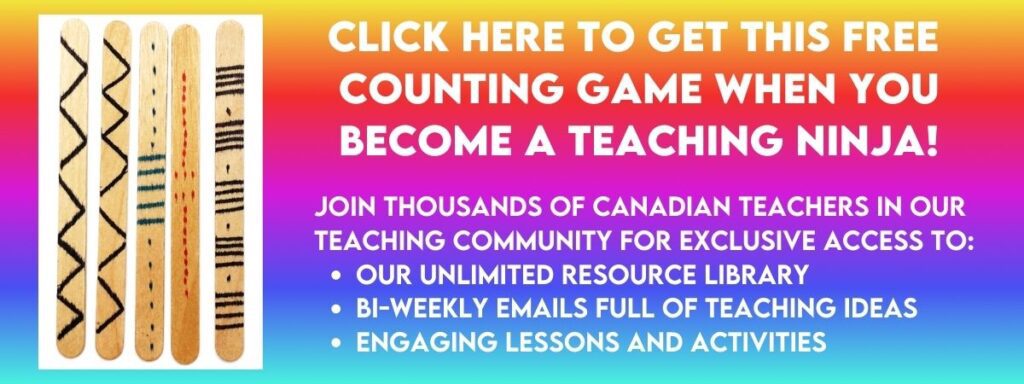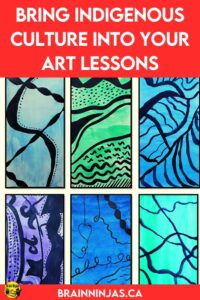
Incorporating the stories and culture of Indigenous people is important to us. It’s woven throughout our subject areas, but we often look for other places to provide opportunities to bring cultures together. We’ve had several students who share their Cree and Dene cultures with us. Other years we’ve had no one in our classroom with a direct connection to our Indigenous People. We want all of our students to feel connected to the history of our country and the people who were here first. One way we do this is by exploring the works of Indigenous artists in Canada.
In what ways do we bring Indigenous culture to our school and classroom?
One of our favourite ways to learn about different Indigenous People in Canada is to research Indigenous artists and their works of art, styles, media and stories. We don’t believe that teaching about culture over a single day or week is right. Cultures should be taught every day. We try to bring our local Indigenous groups into our classroom as often as possible.
Bring in Guests
Our school is open to cultural celebrations. We have regular guests who tell us about their lives and teach us about the history of different Indigenous People living in the area. Every time we meet someone new, we learn more and more. It is a continual learning process.
While we’ve had dancers, artists and storytellers one of our favourite activities was when a group of Cree women came to our school to teach our class how to make moose soup and duck soup. Students were fascinated with how these women didn’t just go to the grocery store to buy moose. It was hunted earlier in the year by some family members. One of the most telling comments was when one student said, “I didn’t know Indigenous people ate moose. I thought it was just bannock or pemmican.”
Explore Food and Regalia

We got to learn all about the different foods these women grew up eating-and most of them ate things just like we do. No pemmican, but bannock is a favourite for everyone. Students learned that their textbooks often didn’t have all the information or they had information that was only accurate for one group of Indigenous People, but not all.
Another year we had a young male dancer who was showing off his regalia and one of the boys wanted to know how it was made. The dancer explained that he had learned to sew and that it was common for the men to sew their own outfits for dancing. Sewing was an important skill for hunters historically and he was very proud to be able to sew and pass that skill on to his own children one day. We had several boys who started researching sewing projects they could do independently.
These are experiences we never had as students ourselves. We are dedicated to teaching our students about all cultures in the world, but we are constantly learning, too.
Art is a common language for everyone.
We don’t mean everyone has to be great at creating art. Our students regularly laugh at our drawings (and there’s a reason we don’t sell clip art), but we do know how to encourage our little artists to explore different media and you don’t have to be an artist to be inspired by the work of an artist.
Studies have shown that teaching art in the classroom improves attendance. It promotes self-directed learning as many students will work on their art skills outside of the classroom simply because they enjoy it. Art improves critical thinking and creative thinking.
Art for English Language Learners
For students that are learning English, art is often a break their brains need from learning the language. Going to school in a new language is exhausting, but art is a quiet relief that relies more on the visual than the aural and this often means these students get a chance to be equal to their peers.
Art for Reflection and Refinement
Art teaches students to evaluate and reflect. They get to decide what appeals to their own eyes or how they want to change or improve their own work.
Art for Fine Motor Skills
Making art helps improve fine motor skills. The students that often struggle with printing and cutting often struggle with painting and sculpting, but because of the “freeness” that art class allows, these students get to just create without the need to be perfect. And sometimes the messy stuff is great (talk about an abstract artist!).
Are you avoiding teaching art because of the mess and time it takes? You need to read this post we wrote about that very problem.
Students who create art have to make decisions throughout their projects. They learn to make quick decisions and stand by them with confidence.
All cultures in your classroom should be discussed and celebrated. Too many times cultural activities revolve around a specific event or celebration, but by tying cultural lessons to art class, they can happen throughout the school year.
So why Indigenous artists in Canada?
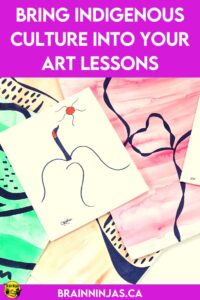
Over the years we connected with some of these Indigenous artists directly to learn from them and share stories about our student creations. Language Arts, Social Studies and Art all collide during these lessons. Students are able to make deeper connections by integrating subject areas.
We did some research by talking to locals about why some Indigenous groups have lots of art incorporated into their culture while others do not. For example, the Haida carved large cedar trees into intricate patterns and make totem poles, but when we searched for artwork that was historically part of the Cree life, we could only find beading and that was only after colonization.
Why Do Some First Nations Have Popular Art and Others Don’t?
It was explained that the Haida lived next to their food source and lived in one place year-round. They had time to create large works of art that stayed with them. The Cree spent much of their time travelling with the large buffalo herds across the prairies as they hunted. Their art was more about storytelling than creating decorative objects.
It makes perfect sense when you think about it. We are all affected by our geography. We eat the food that grows the closest and choose jobs that are in the area where we live. It would only make sense that we create art from the world around us, too.
How Does This Affect Our Art Class?
So, we searched for Indigenous artists that are more modern but use their personal connections to create beautiful pieces of artwork.
We’ve looked for art projects that use a variety of skills such as painting, sculpting and drawing. We’ve looked for artists that use a variety of media such as paint, watercolour paint, ink, soapstone and pastel. It’s been so interesting learning about the cultural significance of art to these artists.
We do not have any special training to teach art as we are elementary generalists. Even then, we are expected to teach art in our classroom. Art is very subjective. We look for different projects to explore art while learning about different styles in the process.
We collected these lessons over a few years and continue to look for more all the time.
There are so many Indigenous artists whose stories about their art can inspire your students.
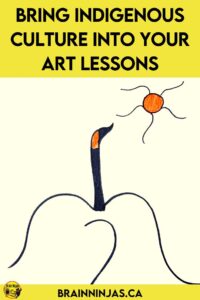
The next section of this post contains links to find the books mentioned. These are not affiliate links. We just like them.
One of our all-time favourites is Métis artist Dana Standinghorn. Her bright and colourful work can be found in The Giving Tree: A Retelling of a Traditional Métis Story and My First Métis Lobstick. She has become an illustrator for a new series of books from Nelson Educators called Under One Sun.
Try This Free Lesson
We wrote an art lesson that accompanies her books and artistic style that you can download the lesson for free in our store. We wrote an extra post just about this lesson to read a little more. Find the free lesson on TpT or our BN Shop.
If you enjoy that, grab our Indigenous Artists in Canada Inspired Art Projects. It features several different artists from all across Canada. Find it on TpT ($USD) or BN Shop ($CAN). We have also written a blog post that includes the biographical information of several different Indigenous artists in Canada.
We often start off our searches for art lessons simply by looking at the artwork on the internet. When we see something that catches our eye, we work backwards to think about how it could be recreated in our classroom with our “regular art supplies” like paint, paper and pastels.
Occasionally we find a book where the illustrator dazzles us and we feel the need to recreate the art. Our students bring us books that they enjoy and then we research the authors and illustrators.
Art captivates students. Ask them to show you some of their favourite art pieces and then create new pieces inspired by those works.
Appreciating art is just one way to appreciate culture.
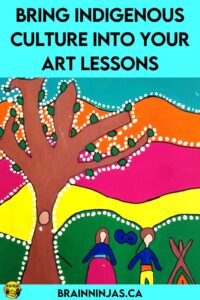
Most importantly, we teach our students that culture is full of a variety of people with common interests and values, but without stereotypes. We want our students to respect all cultures by learning as much as they can about each one. Art is just one way we learn about Indigenous cultures in Canada. We try to teach our students about Indigenous people each and every day by providing real experiences with real people.
Aside from visual arts, we worked with several people to learn more about different Indigenous cultures and their history in Canada. We were very lucky to get to work with guest dancers. Our female students had the chance to learn portions of the shawl dance while our male students worked to learn some simple steps for a hoop dance. They loved it and we’ve tried to have these dancers come back on a regular basis. We even had a grandmother who made a set of shawls for our students to wear. They wore them when they danced at an assembly.
Drama is another way we connect to Indigenous cultures. We often read stories and then act them out. We’ve even done some drama circles in order to learn more about the history of different cultures. You can find these items in our store.
Turtle Island Drama Circle: This tells the story of colonization and how the Indigenous People were unfairly treated. Find it in our TpT Store ($USD) or BN Shop ($CAN).
Seven Teachings Drama Circle: This explains the Seven Grandfather Teachings that are taught in many Indigenous communities. Find it in our TpT Store ($USD) or BN Shop ($CAN).
Drama circles are a simple activity. Students read a card to perform an action or say something in particular. This triggers the next speaker until everyone in the circle has read a card or two. The entire series of cards tell a story. Learn more about the benefits of drama circles.
Learn a traditional game.
Teach your students a traditional game. We have written out the instructions for the Bone Game. Your students can make their own version and give it a try. Find it in our Resource library or we can send you a copy when you join our mailing list.
Art is a very natural way to connect to cultures. What lessons do you bring into your classroom to honour Indigenous People in Canada? Let us know in the comments below.

